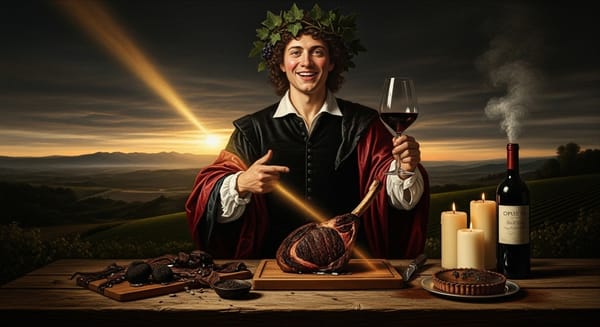Meursault Unveiled: Burgundy’s Golden Chardonnay Sanctuary
Discover Meursault, the Côte de Beaune village where Chardonnay turns limestone and sunlight into silk. From Roman roots to biodynamic futures, explore why collectors and dreamers chase its luminous bottles.
Introduction
A breathless pause tugs at passengers whenever the train from Dijon glides into the Côte de Beaune and the vineyards around Meursault flare under sunlight—terraced rows that shimmer like pale coins scattered across the slope. In that instant, the land seems to breathe through Chardonnay’s slim green lungs. I have chased many wines across continents, yet Meursault lingers like a half‑remembered lullaby: part tenderness, part ache. Today, let us wander these vines together, tasting the mineral memories beneath each crust of earth and savoring the brightness that endures even the coldest nightfall.
A Village Forged in Reverent Stillness
Two thousand years ago, Roman centurions bivouacked along a Gallic roadway they dubbed Murissaltus, “mouse‑wood,” pushing vine cuttings into loamy pockets beside their cooking fires. Those humble slips of vitis vinifera rooted in clay and limestone, gripping this hillside with quiet determination. Centuries later, when imperial banners fell and marauding Franks rattled the valleys, Cistercian monks arrived carrying chisels, candles, and faith. They terraced the slopes, built drystone walls, and recorded pruning dates next to psalms, coaxing Chardonnay as delicately as they illuminated manuscripts.
By the Renaissance, dukes measured wealth not just in silver but in barrels branded Mersault (the spelling would keep evolving). Barges groaned down the Saône toward Parisian taverns where philosophers debating liberty lubricated their tongues with nut‑tinged sips from Beaune.
Then came catastrophe. In the 1870s phylloxera—an aphid no bigger than a pepper grain—chewed roots into lace. Vignerons burned entire parcels in grief‑tinged bonfires. Salvation required grafting European scions onto American rootstock: a marriage of desperation that rescued old flavors inside new skins.
The 20th century tested courage again. Trenches scarred nearby hills in the Great War; later, Panzer columns rattled past stone crosses in 1940. Cellars became bomb shelters; barrels, makeshift tables for meager rations. Yet growers safeguarded mother vines, noting frost, blossom, and barrel orders in looping copperplate even as artillery thundered beyond.
Today, Meursault balances reverence with gentle rebellion. Solar panels gleam atop seventeenth‑century eaves; interns from Melbourne and Mendoza speak three languages while washing presses; and at dusk, owners still walk the rows, rubbing leaves between finger and thumb as their grandparents taught them, seeking mildew’s scent on the wind.
The Arc of Light and Stone
Climb mid‑slope in Les Charmes and feel the land’s subtle cant—just enough to drink late afternoon sun while shielding clusters from brutal mistral gusts. The first spadeful is a crumble of ancient seashell and pale clay that gifts breadth to the palate. Dig deeper and you strike fractured Jurassic limestone, veined like an aged palm; it sparks saline electricity through the juice. Below that lies rusty scree that whispers iron, adding a faint sanguine glow you taste rather than see.
Meursault perches on a climatic knife‑edge. July afternoons can scorch past 35 °C, bronzing skins to the color of apricots; yet night drafts tumble down from the Hautes‑Côtes, plunging temperatures by fifteen degrees, trapping acidity inside the berries as though behind a wax seal.
Climate change scribbles fresh marginalia. Budbreak tiptoes earlier; hailstorms arrive like thrown marbles; vintage calendars feel like musical chairs. Growers counter with higher canopies that shade fruit, carpets of fava and mustard that cool soil, and drip lines used sparingly when drought threatens root hairs. Through it all, limestone keeps the beat—absorbing heat by day, exhaling coolness after dusk, ensuring flavors stay taut even in solar vintages.
Vines Kept Lean for Music, Not Volume
At dawn in Perrières, trunks twist like arthritic hands clasping rosary beads, each vine a chronicle of half a century. Roots tunnel ten metres down, sipping secret springs that evade human maps. The berries they offer are no larger than wild blueberries—minute capsules of fragrant torque.
Synthetic herbicides vanished after the 1990s awakening. Copper cauldrons now bubble with nettle infusion, chamomile tea, or silica spray, each potion aimed at strengthening epidermis, energizing sap, or calming a restless canopy. Winter sheep graze between rows, mowing cover crops while fertilizing the earth with gentle hoofbeats.
Yield discipline feels like orchestration: one cluster per shoot whenever possible, two if the season smiles. Vignerons chew seeds rather than trust spreadsheets; when crunch surrenders to velvet and seeds turn russet (never ebony), harvest teams gather before sunrise—headlamps bobbing like a constellation at ground level. Drones guide pickers to ripest pockets, yet intuition still calls the tune. One grower gauges harvest by spider behavior: when webs drop lower, fruit flies gather, and picking commences at dawn.
Chardonnay, Spoken with a Meursault Accent
Elsewhere, Chardonnay may flirt with mango or pineapple; here it speaks orchard French—ripe pear, baked quince, and roasted hazelnut soaked in browned butter. In its first two springs a village cuvée bursts with kumquat zest and acacia bloom. Give it five winters, and brightness folds into depth—mushroom leaf‑litter, warm brioche, and that telltale pierre à fusil spark when flint meets steel.
The mouth stages a three‑act play. Act I — Generosity: glycerol glides over the palate like silk dipped in honey yet finishes dry. Act II — Tension: lime peel, sea spray, and crushed shell zip along an acid spine tuned like a violin string. Act III — Resonance: almond skin, chamomile, and faint smoke echo long after the swallow.
Analogy clarifies: Chablis is chalk etched in glass; Puligny‑Montrachet is white marble carved by a master; Meursault is supple sandstone—capable of cathedrals yet warm to the touch. No parcel bears official grand‑cru coronation, yet insiders crown Perrières for laser‑lined salinity, revere Genevrières for incense‑spiced silk, and rely on Charmes for a generous golden embrace.
Barrels That Listen More Than They Speak
Descend a spiral stair into a seventeenth‑century cellar: humidity beads on your forearms; the air smells of wet chalk, bruised apple, and faint yeast. Fermentations ignite in 350‑litre casks or concrete eggs, nurtured by native yeasts that hitchhiked on harvest boots. Temperature control remains analog—crack a vent to invite night chill, close a wooden door when must surges.
Malolactic conversion waits for spring, unfolding like distant timpani, softening malic bite into lactic cream while releasing whispers of butter that merge seamlessly with hazelnut rather than drown it.
New oak hovers between 15 % and 30 % for premiers crus; village wines may see none. Tight‑grained staves from Chassin and Taransaud breathe without splintering vanilla. Batonnage, once weekly, now occurs only when texture feels angular. Many vignerons leave fine lees undisturbed for a year, betting on slow autolysis to weave roasted cereal notes into stonefruit. Bottling arrives with the first heatwave of the following summer, as vines above remind barrels their guardianship is temporary.
Voices in Harmonious Dissonance
North of the village square, Benjamin Leroux captures Meursault’s saline heartbeat; his barrels concede only a sigh of cedar, allowing quince and almond to shimmer. To the south, Comtes Lafon shows deliberate precision: Charmes tastes of saffron pastry stitched to a limestone spine—luxury held firmly by discipline. Higher in Perrières, springs murmur beneath Jean‑Marc Roulot’s rows; his wines pirouette like morning dew turning into Mozart.
Fresh voices enrich the choir. Patrick Essa at Buisson‑Charles layers yellow peach over a minerality so taut it hums. Arnaud Ente bottles concentration with hummingbird levity, each release an exercise in poised intensity. Sisters Claire and Elise at Domaine Bernard‑Boyer age a slice of their blend in amphora, sharpening chalky definition, while Heitz‑Lochardet ploughs by horse, sowing pollinator strips that fill vineyards with monarch butterflies—biodiversity you can somehow taste.
And there are whispers of the next wave: micro‑negoçiant Maison Miaud experimenting with acacia barrels, and Domaine des Barres trialing electric tractors powered by rooftop solar, merging tradition with innovation like counterpoint in a string quartet.
Architectures Revealed with Time
Pull the cork on a 2010 Perrières and watch liquid glow like cathedral glass. Primary fruit recedes to almond nougat, white truffle, iodine—echoes of oceans that once blanketed these ridges. A village Meursault can dazzle within two years, yet at ten its skeleton emerges—oak lattices dissolved, limestone spine glimmering like silver filament. Premier crus glide past twenty, especially in cooler harvests such as 2014, where tensile acidity welds structure.
Proper rest is an act of faith. Bottles slumber best at 12–13 °C and 70 % humidity, shielded from vibration and fluorescent glare. Country cellars often outshine city closets; subterranean silence allows sediments to settle in crescent moons. Serve just below cellar temperature—around 11 °C—in broad‑bellied stems. As wine warms to 14 °C, bouquet unfurls: nut skin, bergamot, chamomile, distant tide‑pool salt. Decant only for crystallized tartrate constellations or stubborn reduction. Pair with saffron‑infused monkfish stew, where wine’s hazelnut echoes rouille, or a wedge of 24‑month Comté whose tyrosine crunch rhymes with limestone’s grip.
The Ledger’s Low Murmur
Collectors savor Meursault’s paradox: acreage exceeds Puligny, yet the most luminous cuvées remain fiercely allocated. Perrières, Genevrières, and Charmes command premiums, especially from solar vintages like 2019 and 2020 where ripe fruit rides a spine of preserved acidity. Secondary‑market indices show five‑year compounded growth near 8 % for benchmark domaines—steady, if not stratospheric.
Provenance rules the ledger. Bottles that rest undisturbed in professional storage outshine those shuffled through warm retail shelves. Diversify across stalwarts and rising artisans to buffer vintage swings while sampling stylistic range. Watch estates transitioning to organic or biodynamic certification: early releases can fly under the radar, only to surge once green credentials attract fervent demand.
Yet every seasoned buyer repeats the same counsel: invest first with your palate. Portfolios bloom when joy guides acquisition; wines unloved in the glass rarely prosper in the line graph.
Midnight Manuscript
Night settles over the Côte de Beaune; stars stitch dark velvet where vines blazed hours earlier. Deep below, yeast cells exhale almond, smoke, and sea. Meursault is not artifact but living manuscript—its ink refreshed each vintage, its sentences spoken in sunlight and stone. To drink it is to taste resilience draped in radiance, melancholy held gently by exuberance—proof that beauty can survive upheaval and still extend grace.





